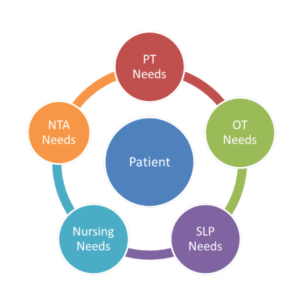Questions & answers from the American Association of Nurse Assessment Coordinators (AANAC)
Q: Regarding coding of assistance with bathing: According to the RAI User's Manual, you code the highest level of assist given in the past seven days. In theory, therefore, if someone received a total assist to bathe, with the CNA performing all of the care on one day in the past seven days, even if the resident performed all of her own bathing with set up only on the other days, how can you code this as 4/2 (total dependant/one assist)? As this gives the incorrect description of the resident, I would be hesitant to code this way. I would code the above situation as extensive assist (code 3).
A: You code 4/2. There are many places on the MDS that do not ask for an accurate picture of the resident, but a description of resources used for the snapshot, based on coding rules. The care plan should be the place where we paint a picture of our resident. The MDS is where we follow the coding rules.
Q: Some folks at my workplace say that any resident who goes on hospice must automatically have a Significant Change in Status Assessment completed. Is that correct?
A: No, it isn't. The criteria for completing a Significant Change Assessment for a resident opting for hospice are no different than they are for any other resident. The RAI User's Manual, page 2-11, states:
If a resident elects the Medicare hospice program, it is important that the two separate entities (nursing facility and hospice program staff) coordinate their responsibilities and develop a care plan reflecting the interventions required by both entities. The need to complete an SCSA will depend upon the resident's status at the time of election of hospice care, and whether or not the resident's condition requires a new assessment. Because a Medicare-certified hospice must also conduct an assessment at the initiation of its services, this is an appropriate time for the nursing facility to evaluate the MDS information to determine if it reflects the current condition of the resident. The nursing facility and the hospice's plans of care should be reflective of the current status of the resident.
In addition, on the same page, it says that a Significant Change Assessment is not required for individuals with a terminal condition if the change in condition is an expected, well-defined part of the disease course. So, if your resident has been on a decline due to his terminal condition and has now decided to elect hospice care, that action alone (going on hospice) is not a trigger for a Significant Change Assessment. In these situations, as always, the care plan must reflect the resident's current status.
Q: I have a patient scheduled to go for chemotherapy, and the billing department where the chemo will be administered said they will be billing Medicare but that there are some charges that will be the responsibility of theSNF. Please explain Medicare A coverage for chemotherapy.
A: Some chemotherapy drugs fall under consolidated billing, meaning they are excluded and not the SNF's responsibility. In addition, some chemotherapy administration charges are also excluded if the drug is excluded. Some things that may not be excluded are the anti-nausea drugs administered. I would verify which chemotherapy she is getting to make sure it is not going to be the SNF's responsibility. For a general explanation of the exclusions under consolidated billing, go to https://www.cms.hhs.gov/SNFConsolidatedBilling/Downloads/06MajorCategoryExplanation.pdf. See Major Category III regarding chemother-apy.
To verify if the drug is on the list of exclusions, you need to check the HCPC file that can be found at the following web site: https://www.cms.hhs.gov/SNFConsolidatedBilling/75_2007_FI_Update.asp#TopOfPage.
With thanks to Diane Carter, RN, MSN, CS, President and CEO of the American Association of Nurse Assessment Coordinators (AANAC).
Sidebar
About AANAC
Q: What is AANAC and how do I get my questions answered on the Resident Assessment Instrument/Minimum Data Set (RAI/MDS)?
A: The American Association of Nurse Assessment Coordinators is a nonprofit association of your peers including all members of the interdisciplinary team dedicated to networking, education and advocacy on behalf of all clinicians involved in the RAI/MDS process. From our online discussion group each week, we select the best questions and answers our members have raised. The questions and answers are reviewed by a national advisory board of experts in this field and they are subsequently published in NAC News, our weekly online newsletter. In addition to our weekly questions and answers, the newsletter contains all sorts of timely and accurate information on this process. AANAC also offers certification and other educational information services for clinicians committed to accurate and timely completion of the MDS. For further information on AANAC, visit https://www.aanac.org or call us at (800) 768-1880.
I Advance Senior Care is the industry-leading source for practical, in-depth, business-building, and resident care information for owners, executives, administrators, and directors of nursing at assisted living communities, skilled nursing facilities, post-acute facilities, and continuing care retirement communities. The I Advance Senior Care editorial team and industry experts provide market analysis, strategic direction, policy commentary, clinical best-practices, business management, and technology breakthroughs.
I Advance Senior Care is part of the Institute for the Advancement of Senior Care and published by Plain-English Health Care.
Related Articles
Topics: Articles , MDS/RAI , Regulatory Compliance












